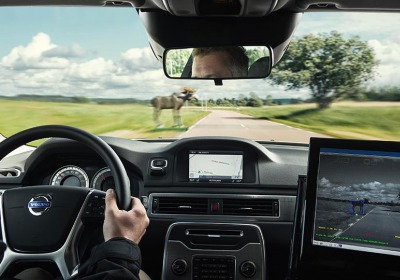Upcoming Volvo XC90 gets new safety tech
Wed, 10 Jul 2013
The Volvo XC90 has been with us for 10 years now -- a long time indeed when it comes to product life cycles of comparable upmarket SUVs. The stylish sport utility was a popular seller in North America for a good part of that decade, and for a while was even offered with a 4.4 liter V8 engine developed by Yamaha and shared with the second-gen S80 (a first for a Volvo passenger car).
But if there's one thing Volvo is known for, it's not V8 engines -- it's safety.
While the S80 sedan will get a facelift for 2014, the 2014 XC90 will be all new. And a few months before its debut, Volvo has shared with us some of the innovative safety technologies we are going to see when the new SUV premieres.
First up is pedestrian detection in darkness, which will be combined with Volvo's auto brake technology to sense people moving in the path of the vehicle. A number of automakers, Volvo included, have offered pedestrian detection and infrared heads-up displays before, but Volvo here takes it one step further, automating the system and enabling it to sense approaching persons in darkness. This is a much-needed advancement, as the traffic fatality rate in the U.S. is estimated to be three to four times higher in darkness than in daylight.
A related piece of safety technology is the XC90's animal detection. Volvo is the first automaker to offer a system for animal detection, and it will work both in daylight and at night. As most collisions with animals occur when cars are traveling at highway speeds, this is another no-brainer.
The XC90 also offers road edge and barrier detection with steer assist, where the car's road surface monitoring systems will keep track of the car's direction, applying the steering to keep the car on the road when it sense that it is likely to depart paved surfaces. The system will also sense road barriers and other fixed and temporary surfaces around the car's path, as those often pose a significant risk of collision when the driver is distracted.
The next major system that will make its first appearance in the new XC90 will be adaptive cruise control with steer assist, which will help drivers stay in lane by monitoring the flow of traffic ahead of the car and applying the brakes before the car gets too close to the vehicle up ahead. This system builds upon lane keeping technology already available in Volvo cars today.
If you take a close look at the direction in which these safety technologies are taking us, it becomes apparent that we're only a couple model generations away from self-driving mass market cars. Some have already been approved for use in a number of states via legislation, a minor miracle in itself when one considers the typical lag time for such dramatic steps. The technologies that we are going to see in the new XC90 when it debuts next year are essentially halfway points between what we have now, and autonomous vehicles.
By Jay Ramey



